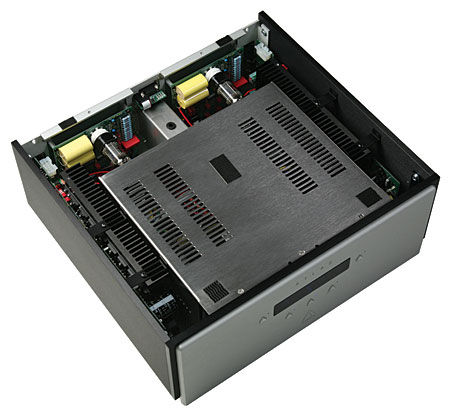| Columns Retired Columns & Blogs |
Aesthetix Atlas power amplifier Page 2
On Los Lobos' live cover of Cream's "Politician," from Just Another Band from East L.A. (CD, Slash 45367-2), David Hidalgo's lead guitar had all the screaming assertiveness of Clapton's original. The Atlas gave the band the appropriate heft of a heavily amplified rock band in a large venue. Through the Atlas, the track rewarded play after play, at increasing loudness. No, you can't reproduce the concert experience at home, but the Aesthetix proved you can get satisfyingly close.
Of course, that level of audio verité wasn't all the Atlas's doing—almost every rock track I played after "Politician" sounded flat in comparison. That said, my experience has been that truly great components accentuate the differences between great and merely good recordings, whereas ordinary hi-fi flattens the effect. The Atlas made Los Lobos jump to life.

The Hilliard Ensemble's performance of the Introitus of Orlando di Lasso's Missa Pro Defunctis (CD, ECM New Series 1658) had a hushed intimacy that nevertheless filled the chapel acoustic of the Boxgrove Priory, in Chichester. Gordon Jones's baritone rooted the sound with palpability, letting tenors John Potter and Rogers Covey-Crump flesh out Lasso's moving blocks of sound, as over it all soared countertenor David James. What the Atlas got right about the Introitus was that it was simultaneously physical and ethereal. The voices floated—but they also collided against one another. And for all the beauty of the four voices working through Lasso's winding, soaring melodies, the hushed resolution of the final major chords is a physical release. The Atlas got so much so right—Introitus was an eargasm.
Charles Mingus's "Cumbia & Jazz Fusion," from the eponymous album (CD, Atlantic 8801), shares with Mahler's music an emotional complexity as well as a rootedness in folk melodies. After a relatively simple opening, "Cumbia" rocks out, buoyed above Mingus's heavy bass line. Various instrumental choirs trade phrases with one another, separated by Ellingtonian ensemble choruses. It's a 28-minute journey into a complex soundscape—always, but especially so through the Atlas.
Titan vs Olympian
I'd been lucky enough to hang on to the Parasound Halo JC 1 monoblocks until early fall, so it seemed appropriate that I compare them to the identically priced Atlas. I was about to joke that it's a tough job that somebody has to do, but the fact is, comparing amplifiers as good as the Parasound and the Aesthetix is hard work. Apples to oranges is an easy comparison—but McIntoshes and Park's Pippens? That's tougher.
The Atlas revealed more midrange presence in the Tin Hat Trio's "The Would-Be Czarina"—not an astonishing amount, but the song had a tad more three-dimensionality with the Aesthetix. One thing both amps got right, however, was the overall timbral balance. This music is light as air, and both amps remained true to that delicacy.
While I thought the Atlas got the midrange righter, the JC 1s had more top-end extension. This is an area of endless debate among audiophiles: extension or midrange timbre? It's a matter of preference, in my opinion, and not so much one of right and wrong.
As for Los Lobos' "Politician," while I felt that the Atlas had all the slam needed for kick-ass rock'n'roll, the JC 1s had even more wallop—and, again, a little more HE extension, although I thought it bordered on too much. However, "bordered on" is far from actually being too much. I wouldn't call the JC 1s wrong, and another listener might well call them spot-on.
I was less equivocal about the amplifiers' reproductions of Lasso's Introitus, although again, the differences were extremely subtle. The Atlas's creamier midrange brought the Hilliard's four voices more vividly to life for me, and placed them deeper in the acoustic. The JC 1s, I felt, were a tad less vibrant in the middle, and just the slightest bit flatter for it.
On Mingus's "Cumbia & Jazz Fusion," however, the monoblocks did a better job of distinguishing among all of the elements Mingus threw into the piece—the bird calls, percussion, and various folk instruments that populate the field behind the sonic foreground of this big band. There was also no doubt that Mingus's bass (which is rumored to have been amplified for this, his final recording) had a lot more body and slam through the Parasounds. That's not to say the Aesthetix was without its charms; its ability to wrest color from the midrange gave it an immediacy that also attracted me, if slightly less than the JC 1s.
This Atlas didn't shrug
Naming an amplifier after the Titan who supported the firmament—or the world itself—is a gutsy thing to do. However, Jim White's Aesthetix Atlas makes a strong case for a power amp being the structural support of a hi-fi system. Certainly, the construction and quality of the Atlas are in keeping with its namesake.
But for all its strength and grunt, the Aesthetix Atlas revealed itself to be quite graceful in its portrayal of music and music's physical, insubstantial substance. No one could call the Atlas a "bargain" at $8000, but neither could they gainsay its worth. It's one of the really great amplifiers I've had in my system recently, and I hope I'll be listening to it even more in the months to come.
- Log in or register to post comments




































